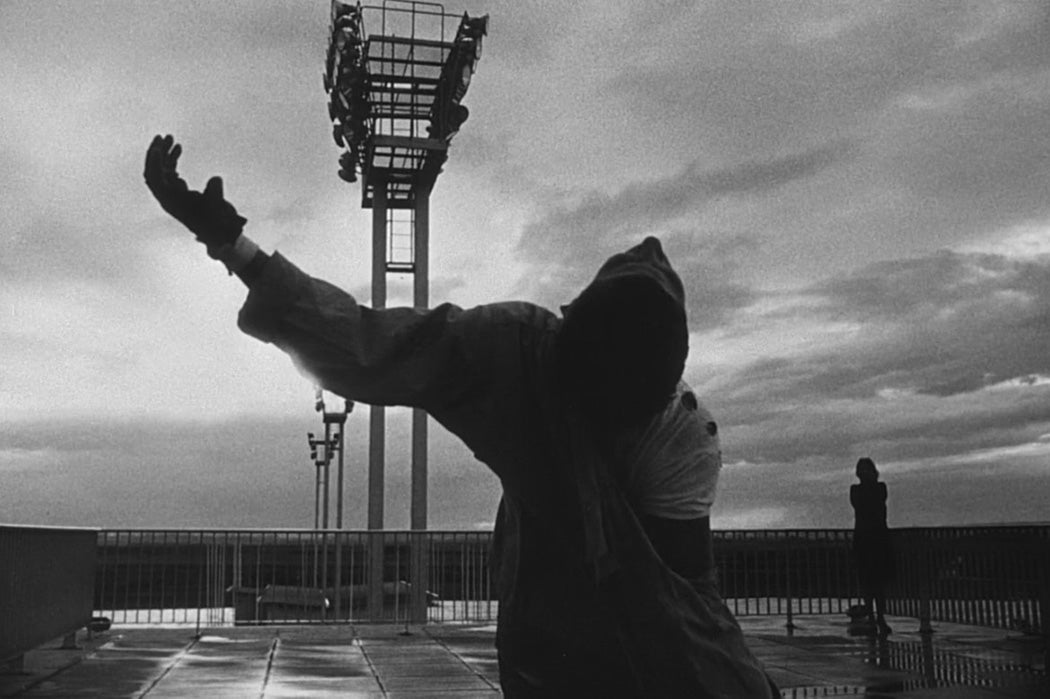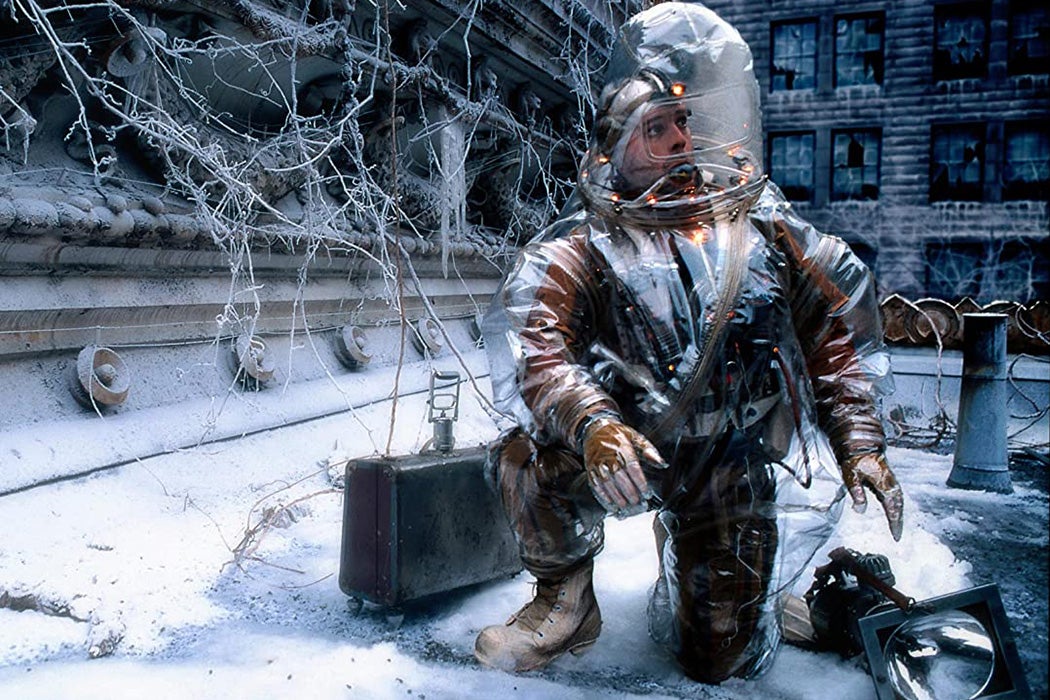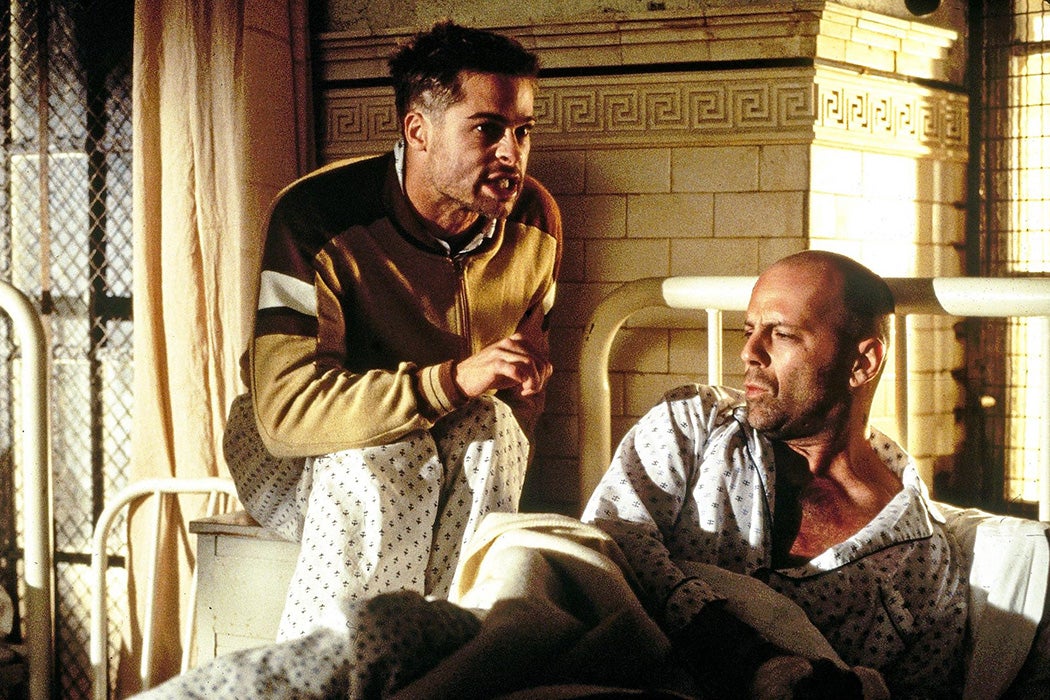Just after jumping backward in time and crash-landing in a Baltimore jail cell, James Cole—the protagonist of 12 Monkeys, the 1995 film by Terry Gilliam—says: “Love the air here. Very fresh. No germs.” If you’re one of the millions who’ve been gravitating to virus films lately, you might have seen it recently, or the TV series that ran from 2015-2018, spawned from Gilliam’s film.
In fact, Gilliam’s time-jumping, apocalyptic movie was inspired by La Jetée, a beloved film in the art-house canon. As the geopolitics of discovering where Covid-19 began heat up, and the class divisions around surviving quarantine stay on our minds, the films—Gilliam’s and La Jetée both—are a mirror to today’s pandemic society.
Weekly Newsletter
Shot entirely in black and white still photographs and with a mere 28-minute run-time, Chris Marker’s 1963 film is unlike any other work of cinema. Indeed, La Jetée has become a critical work of film and photography, but its story is unquestionably informed by science fiction. “La Jetée’s narrative is set in the aftermath of WWIII, when a handful of survivors have taken shelter underground from the deadly effects of radioactivity,” writes Elena Del Rio in Science Fiction Studies.
What follows provides the blueprint for 12 Monkeys. Underground, doctor overlords experiment on humans, seeking to find a “hole in time,” through which one of the subjects will be sent to bring back resources to restart the dead world. To make the journey, they choose a man with an unbreakable childhood memory. Not only are the doctors creepily invading the human subjects’ bodies, they’re peering inside their minds. “The camp spied even on dreams,” the narrator says. This man’s vivid memory is set on the viewing pier at Paris’s Orly airport (the eponymous Jetée.) In the memory, a boy gazing at airplanes witnesses a man shot to death. The moment is depicted in one of the film’s iconic images—a man falls backward, almost dancer-like, to his death.

It’s only by jumping through the hole in time that our nameless hero finally realizes the truth: The moment etched in his memory was of his own death. The body exploding from a gunshot was his. An instant before death, he finally understands what this memory means—his death is also a moment of revelation.
This circular nature of the film has captivated critics and scholars. Rosalind Krauss, writing in October, suggests that Marker may have created an entirely new cinematic language. Screenwriter Larry Gross, in Film Comment, writes: “La Jetée is a dazzling mingling of Borges, Proust, Hitchcock, Cold War anxiety, and erotic nostalgia.”
While nuclear war destroyed the world in La Jetée—reflecting that era’s Cold War anxiety—12 Monkeys’ world-ending war begins with a deadly virus. Released in 1995, its narrative is grounded in the anxiety around another 20th Century epidemic, which by then had infected half a million people in the US alone: AIDS.
But scholar David Lashmet argues that 12 Monkeys goes beyond a virus narrative connected to the AIDS crisis. Its apocalypse, he writes, can be read “as a psychological phenomenon, a ‘plague of madness’,’’ and “reveals the power dynamics of modern medical institutions and predicts their dystopian future.” The film’s settings emphasize this. In Cole’s first time-jump, Lashmet notes, he only appears in three places: “A police holding cage, a panoptic psychiatric ward, and a total isolation chamber.”
That psych ward is the setting for some of 12 Monkeys’ most entertaining scenes, and where we encounter a twitchy, freaky Brad Pitt as Jeffrey Goines, Cole’s fellow ward resident and tour guide. After escaping the psych ward with Goines’ help, Cole (played by Bruce Willis) embarks on his mission to find the Army of the 12 Monkeys, believed to be the creator of the plague. But as it turns out—spoiler!—the Army’s not to blame. Goines’ wealthy father is the scientist who created the virus.
While Cole is a prisoner in the machinations of his overlords, who send him whizzing back and forth in time, Goines has a safety net, through his father’s wealth, which he squawks about to the psych ward staff: “My father will get me transferred…Wait till you morons find out who I am! My father’s going to be really upset.” Goines uses his class status to project that, without a doubt, he’s not crazy, and that he has the means to escape, and survive the coming apocalypse. 12 Monkeys, reminds us that wealth seems to be the ticket to surviving global catastrophe, and always has been, even today, as we face Covid-19.

Cole is on the bottom rung not only because he lacks the safety net of wealth, but also for another reason: He’s a criminal. It’s an eerie parallel to the dangers facing inmates in the age of Covid-19. In La Jetée, the nameless protagonist is chosen for experiments because of his vivid childhood memory. In 12 Monkeys, Cole is serving a life sentence, and the scientists dangle a pardon as reward for the experiments. In La Jetée, the scientists believe this man and his vivid childhood memory is key to curing the destruction. Cole, though, is expendable. In other words, in La Jetée, the protagonist is chosen because he has potential. In 12 Monkeys, Cole is chosen because he has no potential.
Elena del Rio’s analysis of La Jetée expands on how potential, or loss, connects to the theme of time travel. La Jetée’s fixed, stark images, she writes, are “anchored in the past”, which she calls “the temporal mode of loss.” On the flip side, the future is about, as she writes, “fulfillment” of our human desires. La Jetée’s protagonist experiences fulfillment when he understands his own memory. But for Cole, in Gilliam’s film, the moment when he witnesses his own death is also the moment when the virus is unleashed on the world. Turns out, the killer virus has been stolen by a lab assistant/conspiracy nut working in the virologists’s lab. Before Cole can catch him, the assistant boards a plane to unleash the virus on every continent. Watching the final moment, when a police officer shoots Cole in the back, the viewer has a sense of energy being released—the dread that has followed Cole for the whole film finally transforms into understanding. But, that same instant is also his death, and the beginning of the death of billions. Cole has been moving through time, unfixed, but all at once, in the explosion of the gunshot that kills him, the destination becomes fixed, in the decisive moment of death.
This moment in 12 Monkeys when the virus slips out of Cole’s grasp recalls the “highly contentious” theory that Covid-19 was manmade in a lab. What follows is a critical scene: The villainous lab assistant sits down on the plane, and next to him is one of the scientists controlling the experiments on Cole. She then delivers the line that critics have suggested the film’s complexity hinges on: “I’m in insurance.”
Lashmet’s argues that the scientist has traveled back in time, not to stop the lab worker’s evil scheme. She’s there to assure the virus’s dissemination. Lashmet’s reading suggests there can be really only two purposes for her being there: profit, or power. By not stopping the villain before he releases the virus, Lashmet writes, “The medical overlords are allowing the death of billions in order to assure their [own] later ascendancy.” In the world of Covid-19, the scene speaks to how anxious these times are for the millions facing healthcare insecurity—we should be scared not only of the guy with the virus one seat over, but also of the insurance lady sitting right next to him.
In today’s Covid-19 world, the theory that perhaps the virus was a deliberate act rather than a tragic development of nature is a fearsome thought. As the geopolitics of the investigation into Covid-19’s source evolve every day, the thought that world leaders are focused on political self-gain is a scary one, too. Rewatching 12 Monkeys in this light makes the film’s warning clear: The thing we should really be afraid of during a pandemic is people seeking to profit from the pandemic.
12 Monkeys spawned a TV show that ran from 2015-2018 on Syfy, making it a distant cousin of La Jetée. (Or, a copy of a copy? Replicating, like a virus? Yikes.) The show has a few faint traces of La Jetée, including a character named Aaron Marker. (La Jetée’s director was Chris Marker.) The show’s German doctor could be a call-out to the whispered German speech that pops up in La Jetée. (Critics think this might have been meant to evoke Nazi medical experiments.)
Of the many differences between Gilliam’s film and the TV adaptation, the most important is the shift from saving to survival. Where Cole’s aim in the film is to prevent the pandemic, in the TV show, it’s just to survive it. Novelist and critic Stacey D’Erasmo writes in a 2016 essay that the show is part of an apocalypse trend in contemporary popular culture. Its treatment of plague makes the show more akin to a zombie flick, where, as D’Erasmo writes, there’s a “constant utilitarian busyness” that characters go through to survive. “The running and gouging and barbecuing and so on,” D’Erasmo writes.
D’Erasmo notes that the show, and many creative works in the apocalypse genre, tackle the “queasy question of whether or not hope is possible” Syfy’s 12 Monkeys makes a number of choices that prompt viewers to ask this question themselves. The heroine, Dr. Kathryn Railly, has been renamed Cassandra. The name evokes Cassandra, a figure from Greek mythology who could see the future, but was doomed to be disbelieved. The switch suggests that the character is not just warning us about Cassandra, but she is Cassandra. The apocalypse has already happened, and we didn’t believe her.
Dr. Railly in the film is a psychiatrist, but in the show, she’s an infectious disease specialist. The shift could suggest that the “plague of madness” has infected even the person tasked with treating our mental health. Now, it’s all about triage. On top of that, Railly’s role in the show has been amped up, and she’s seen working inside angles of the medical system—emphasizing that navigating institutions, too, is a skill we need to survive the apocalypse.
D’Erasmo also suggests that, should the apocalypse come, and before the world collapses completely, “folks might find they have a lot of empty hours to fill.” She relates her own experience in New York City in the days following September 11. The city was asleep, and, as she writes, “There was nowhere to go… Time had gone slack.” It’s another eerie callout to the slippage of days as the world hunkers in place, hoping for the end of Covid-19, one that 12 Monkeys and La Jetée, through the use of time travel, emphasize even more.
Fortunately, some scholars, such as Del Rio, have taken a hopeful reading of the apocalyptic ending of 12 Monkeys, one that could have been inspired by the note of discovery that ends La Jetée. (If 12 Monkeys—the show or the film—seem too frightening to watch now, start with La Jetée. Its beauty is comforting.) And as D’Erasmo writes, many apocalyptic works “create a great, aching joy for this world as it is, a renewed appreciation of how much we have to lose.” Plus, watching films about time travel can certainly make you feel better about losing track of things as the weeks pass. As Cole says, “What year is it?”
Support JSTOR Daily! Join our new membership program on Patreon today.







